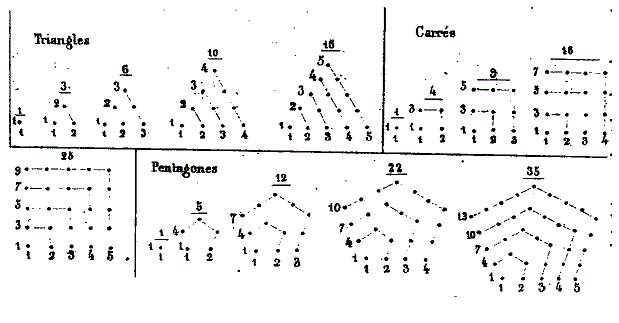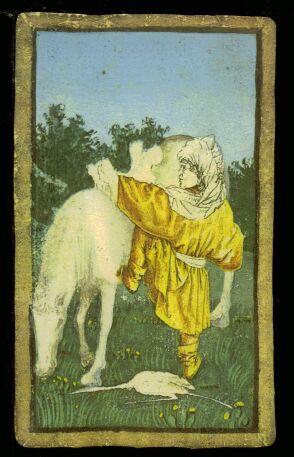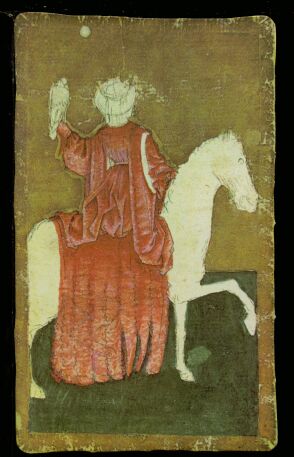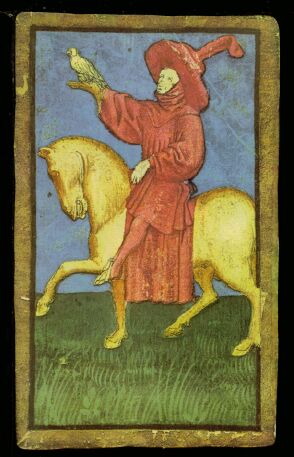So instead of:
Write something like the French for:Contemporary research situates this time in the last quarter of the fifteenth century, because of three documents that have been preserved:
- a literary document: the poems of Boiardo (1487?)
- a deck: the Sola Busca (1491?)
- a list of 22 allegorical subjects: the Sermones de Ludo cum Allis (before 1500)
It is not certain that the Sermones are from before 1500. Decker found watermarks suggesting that the paper itself was c. 1500. Tarotpedia quotes him at http://www.tarotpedia.com/wiki/Sermones ... _Cum_Aliis, but does not give the source, that I can find. Huck may remember where it is. Probably The Playing Card.Contemporary research situates this time as no later than the last quarter of the fifteenth century, because of three documents that have been preserved:
- a literary document: a poem of Boiardo (active c. 1460-1494)
- a deck: the Sola Busca (1491?)
- a list of 22 allegorical subjects: the Sermones de Ludo cum Allis (c. 1500 or before)
There is a recent essay on Andrea's site challenging the 15th century attribution of the Sola-Busca to the 15th century, arguing that it is a century later (http://www.associazioneletarot.it/page.aspx?id=523). It is not convincing to me.
I think you should give sources, or at least links, for the datings in each case, the Boiardo (both for 1487 Huck and for c. 1460 SteveM), the Sola-Busca, and the Sermones (i.e. Decker's article, I think in The Playing Card).
For Boiardo, the Sola-Busca, and the Sermones, links to their tarotpedia entries are possibilities, but I am disappointed at the lack of sources given there. Trionfi.com does not seem to be any better.
For the Sola-Busca, a link to my post at viewtopic.php?f=11&t=988&p=14771#p14771 would probably be sufficient, for the bibliographic information to the most up to date authoritative account, that of a Brera exhibition catalog of 2013. There is also http://www.tarotpedia.com/wiki/Sola_Busca_Tarot, but it does not give a source or a link to this source (even while basing some of its information on it).
As to the question of when Neopythagoreanism entered, or might have entered, the tarot, when I said that it probably was with Poliziano and Pico I was thinking primarily of the designs chosen for the Sola-Busca number cards, as suggesting a Pythogorean-based system useful for divination. I had not yet read Decker's The Esoteric Tarot, 2013, which, it seems to me, presents a convincing case for the possibility, at least, that Neopythagorean considerations affected the placement of the triumphs very early on, even before there were 22 of them. His chapter 5, most of which is available in Google Books, is well worth reading, albeit not swallowed whole: it cannot be quoted as an authority in itself, but it does give very specific references that can be checked and cited. (About missing pages, send me a pm.) He shows that one did not need the Theologumena; or in fact anything only in Greek. The extant and widely circulating Latin texts were sufficient, such as Macrobius, Martianus Capella, Augustine, etc. For specific references for specific numbers, Hopper's Medieval Number Theory, 1938, is also an excellent source, although not available online.
Origen would be another good source, if he was available then. I know that Origen wrote in Greek; what I don't know is if the part cited by Vitali on the Psalms was available, preferably, in Latin in the 15th century. If not, he cannot be quoted as a justification for there being 22 triumphs. I see on Wikipedia that Origen's homilies on the Psalms were translated by Jerome. If so, the necessary quote was probably available, but it needs to be checked.










